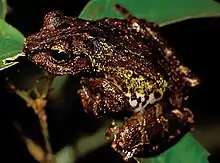Kurixalus berylliniris
Kurixalus berylliniris is a species of tree frog in the family Rhacophoridae.[2][3] It is endemic to Taiwan and occurs in the eastern part of the island at moderate elevations. Prior to its description in 2016, it was confused with Kurixalus eiffingeri.[1][2] The specific name berylliniris combines the Latin words beryllin (meaning "green-colored") and iris, in reference to the green iris of this frog.[1]
| Kurixalus berylliniris | |
|---|---|
 | |
| Kurixalus berylliniris holotype, an adult male | |
| Scientific classification | |
| Kingdom: | Animalia |
| Phylum: | Chordata |
| Class: | Amphibia |
| Order: | Anura |
| Family: | Rhacophoridae |
| Genus: | Kurixalus |
| Species: | K. berylliniris |
| Binomial name | |
| Kurixalus berylliniris Wu, Huang, Tsai, Li, Jhang, and Wu, 2016[1] | |
Taxonomy and systematics
Kurixalus berylliniris was described in 2016. It resembles Kurixalus eiffingeri but displays some morphological differences and a different reproductive season. Furthermore, molecular data and male advertisement call differentiate it from Kurixalus eiffingeri and Kurixalus wangi, its sister species. Together these three species form a lineage that is clearly separate from Kurixalus idiootocus, the fourth Kurixalus species in Taiwan.[1]

Description
Adult males measure 29–42 mm (1.1–1.7 in) and adult females 28–46 mm (1.1–1.8 in) in snout–vent length. The overall appearance is moderately slender and somewhat flattened. The head is wider than it is long. The tip of the snout is pointed; the snout is obtuse in lateral view. The canthus rostralis is curved and prominent. The tympanum is distinct, about half of the eye diameter; supratympanic fold is present. The limbs are slender. The finger and toe tips are expanded into discs. The fingers are slightly webbed and the toes up to about half-webbed. Dorsal skin is granular with small tubercles. There are two color morphs, dark and light. The dark form is dark green to deep tan and has a black X-shaped blotch together with some irregular blotches; the tympanum is light yellowish-brown with small dark spots. The light form is light emerald green, with an obscured dorsal X-pattern. The venter is cream, sprinkled with minute black spots in the gular region. The iris is emerald to light green.[1]
Distribution
This species occurs in eastern Taiwan south of central Hualien, on the eastern slopes of the Central Mountain Range and in the Coastal Mountain Range.[1]
Habitat and conservation
Kurixalus berylliniris has been recorded in moist broad-leaf forests and forest edges at elevations of 225–1,250 m (738–4,101 ft) above sea level. It is arboreal. Eggs and tadpoles have been found in small pools of water in decaying trunks of tree ferns Cyathea spinulosa. The tadpoles are oophagous.[1]
As of late 2018, this species had not been included in the IUCN Red List of Threatened Species.[4]
References
- Wu, Shu-Ping; Huang, Chuan-Chin; Tsai, Chi-Li; Lin, Te-En; Jhang, Jhih-Jia & Wu, Sheng-Hai (2016). "Systematic revision of the Taiwanese genus Kurixalus members with a description of two new endemic species (Anura, Rhacophoridae)". ZooKeys. 557: 121–153. doi:10.3897/zookeys.557.6131. PMC 4740841. PMID 26877703.
- Frost, Darrel R. (2018). "Kurixalus berylliniris Wu, Huang, Tsai, Li, Jhang, and Wu, 2016". Amphibian Species of the World: an Online Reference. Version 6.0. American Museum of Natural History. Retrieved 27 November 2018.
- K. T. Shao (ed.). "Kurixalus berylliniris Wu, Huang, Tsai, Li, Jhang & Wu, 2016". Catalogue of life in Taiwan. Biodiversity Research Center, Academia Sinica, Taiwan. Retrieved 27 November 2018.
- "IUCN Red List of Threatened Species". Retrieved 27 November 2018.